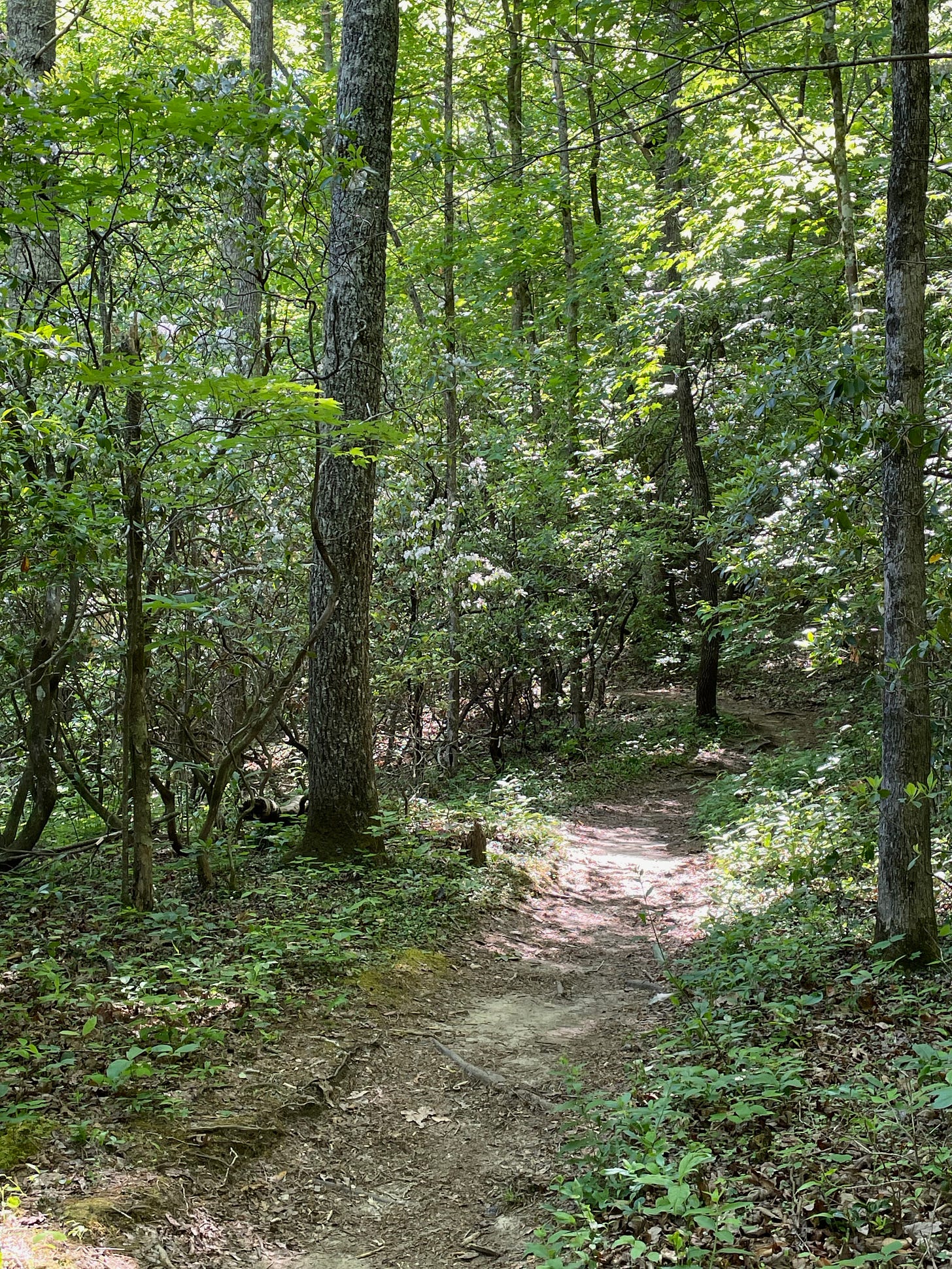Every day, I receive words of wisdom in my e-mail, via a feature called “Daily Dharma.” It comes from Tricycle magazine, and contains quotes from articles featured on the magazine’s website. The people quoted are Buddhist teachers, but the message is almost always universal.
Recently, here’s the Daily Dharma that popped into my in-box:
“Nature teaches us simplicity and contentment, because in its presence we realize we need very little to be happy.”
—- Mark Coleman
As a nature therapist, I love that quote. It makes me think of a forest path I know, a place where I take some of my clients for outdoor sessions. It isn’t fancy. It doesn’t try to impress. It’s green and cool and quite content to be nothing but a forest path.
When my clients and I walk on it, we get simple too. No need to philosophize or say something brilliant. We’re content just to be there walking and breathing, to be 100 percent present.
That’s the lesson of this place, to be honest … and it’s enough.
The Daily Dharma quote also got me to wondering:
What else does nature teach us?
What are the lessons we can learn from this Earth that sustains us?
Do we have enough humility to listen, and learn from those lessons?
Can we understand them?
Are we even paying attention?!?
Some of the lessons I’ve studied in the schoolroom of the natural world were on my own, during solo sojourns. (And by the way, it doesn’t have to be a wilderness expedition. Nature is happy to teach us profound things while we’re sitting on the front porch, or gazing out a window on a rainy day.)
Other lessons have happened while I was sharing nature experiences with my clients. They notice things I don’t. We learn together.
I’m grateful to Mother Earth for all the learning. Here a few of her virtues that inspire me.
SIMPLICITY. As mentioned in the Daily Dharma quote, nature is expert at living simply. Only enough as needed.
Case in point: Consider the daily life of a bird. It wakes before dawn, sings its morning song, then goes about the business of finding food. Much of the day will be spent in that endeavor. There may be idle periods, moments of rest on a branch or the ground, punctuated by the need to stay vigilant for predators. At certain times of the year, the day will include mating, nest-building, the care and feeding of young. Each evening there’s the good-night chorus, then settling down for sleep. A busy day … but a simple day. Taking and consuming only what is needed, no greed, no grasping for more than necessary.
PERSEVERANCE / STEADFASTNESS. Living things in nature don’t complain when the going gets rough. They just hang in there, and try to stay alive.
Case in point: My tea olive shrubs. They’re only a year old, and when we had temperatures in the single digits earlier this winter, the tea olives lost most of their leaves. That’s not normal for them, but it was their response to extreme cold. Then we had a warm February, with balmy spring-like temperatures, and the naked tea olives enthusiastically pushed out new foliage. They figured winter was over. Last week, temperatures dropped again. And all those tender green leaves were burned. Not to worry; my tea olives are once again sallying forth. Their mission is to keep living, to persevere. My steadfast little friends.
FLEXIBILITY. Everything in the natural world adapts to conditions – water, soil, altitude, weather, human incursion. It’s a vital part of the survival instinct, yes, but there’s also an astounding creativity in how living things adjust to their surroundings.
Case in point: Treefall is a natural part of any forest ecosystem. When one tree falls against another, the two often end up in a symbiotic embrace. The standing tree somehow manages to bear the weight of the one that fell on it. They may stay that way for years, even decades – until the standing tree reaches its own demise.
CHANGE / IMPERMANENCE. We see it happen every fall in the Northern Hemisphere. Deciduous trees, shrubs, flowering perennials … all yield to the inevitable. They feel the shorter days, they lose their leaves and their blooms, they hunker down for the coming change in season. No struggle, no resistance – just a graceful surrender.
Case in point: Autumn color is a beloved feature of the Blue Ridge Mountains, where I live. In October and November, we watch reds and golds start to appear at the top of the peaks and work their way down. Some people interpret fall as a kind of death, but it’s only the natural withdrawal of chlorophyll from leaves, as daylight shortens. In March and April, the cycle will reverse and we’ll watch various shades of green start at the bases of the mountains and work their way up. The constancy of change, always there to remind us.
Now it’s your turn! I’m sure there are many more lessons nature offers us. What have you learned from times you’ve spent outdoors? What inspires you in the natural world? Please share in the comments.






Nature has taught me that true beauty lies not in a single animal or plant but in the ecosystem as a whole - the blend, the variety, the competition, the harmony.
Absolutely beautiful post. I have learned most about the changing of the seasons and how much of life is cyclical. There are so many metaphors in nature, almost like the blueprint for life is found in the patterns in nature.